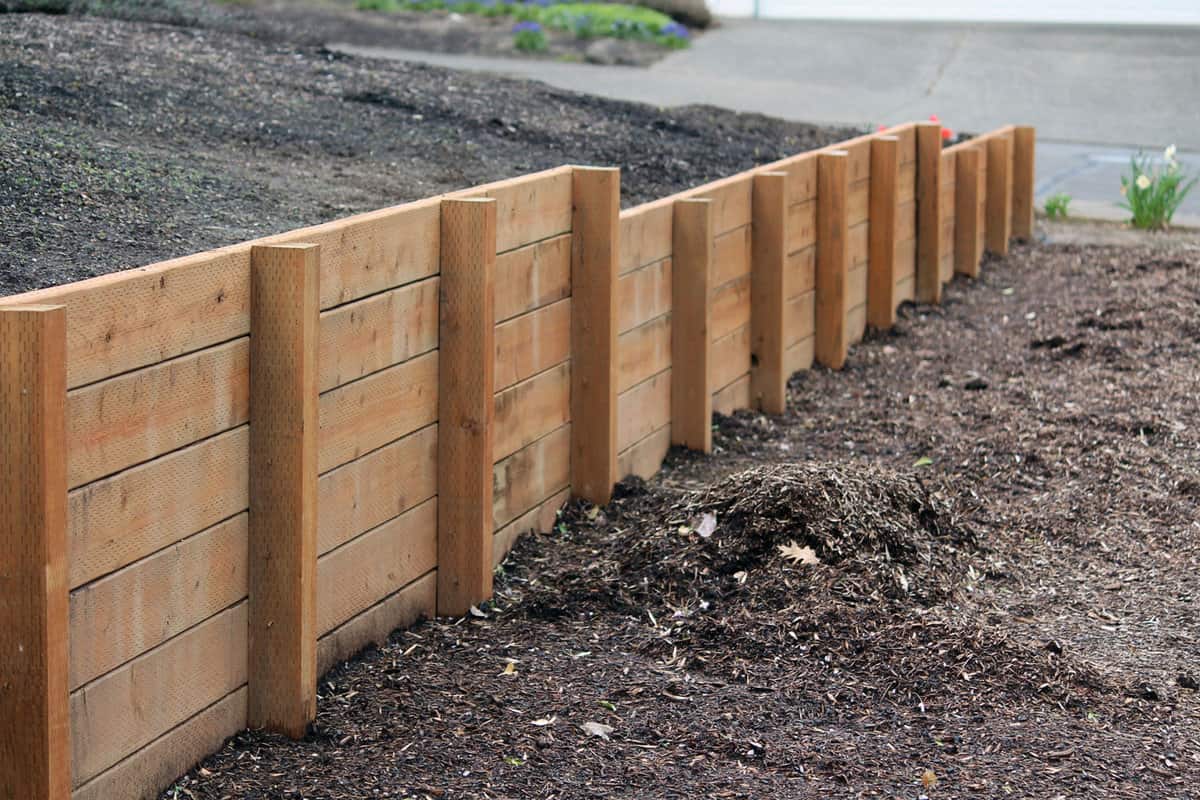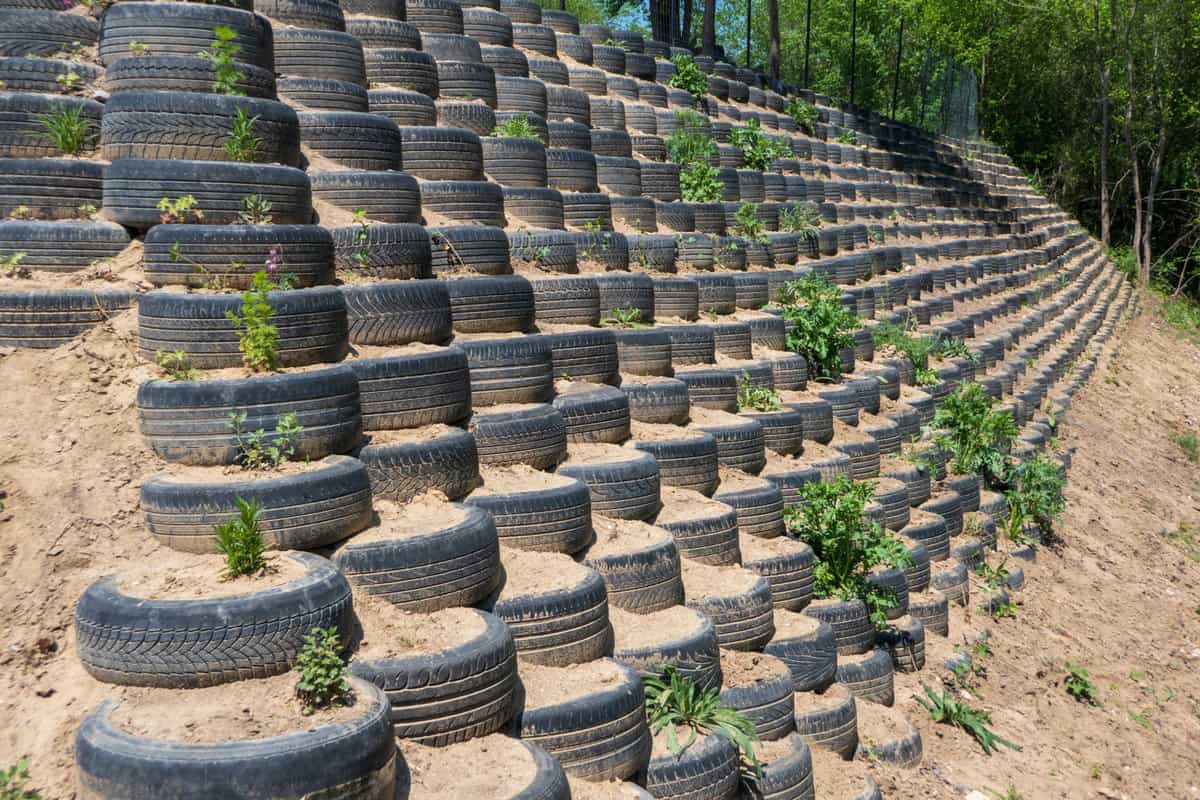Gardening enthusiasts are always on the lookout for innovative ways to beautify their outdoor spaces.
One such idea that has gained traction in recent years is the use of old tires as a retaining wall.

But is this a viable, long-term solution?
When it comes to landscaping, creativity is key. Thinking outside the box can lead to innovative and environmentally friendly solutions.
If you're curious about this unique approach to landscaping, let's explore its potential benefits and limitations.
Basics of Retaining Walls
Retaining walls are structures that help hold back soil, preventing it from sliding or eroding.
They come in handy when you need to create level areas on slopes, control runoff, or stabilize landscapes.

In order to function properly, a retaining wall needs to be built with the correct materials, designed to withstand the pressure from the soil, and include proper drainage.
Strength and durability are crucial factors for a retaining wall. You should also consider aesthetics, as retaining walls can be visible features in your landscape.
There are various materials that can be used to build retaining walls, with some requiring more maintenance than others.
Recycled Tires as Retaining Walls
Building a retaining wall with tires is indeed possible. It is a cheap and innovative way to repurpose and reduce the environmental impact of waste tires.
While not your traditional material for retaining walls, you might be able to create a functional and sustainable landscape feature using old tires.
However, to determine whether tires are suitable for this purpose, you'll need to carefully consider factors like load-bearing capacity, durability, and appearance.
As you consider unconventional landscaping, always prioritize safety and environmental consciousness before making any final decisions.
Read more here: How Far Apart Should Retaining Wall Posts Be?
Why Consider Tires for Retaining Walls
In this section, we will cover the environmental benefits and economic advantages of using tires as an unconventional retaining wall material.
Environmental Benefits
Repurposing tires as retaining walls can help reduce their accumulation in landfills and alleviate the environmental burden.
By using old tires in your retaining wall, you are not only reusing waste material but also making a sustainable choice.
Moreover, when tires are turned into graphene, they can make stronger concrete, presenting the opportunity to reinforce your retaining wall without impacting the environment adversely.
Economic Advantages
Repurposing tires to build retaining walls can potentially save you lots of money.
Tires are often discarded, and their availability makes them an economical alternative to traditional materials such as wood, stone, or concrete.
Utilizing tires also reduces the dependency on newly manufactured materials, making it an environmentally friendly and cost-effective solution for your landscaping needs.
In addition to material costs, using tires can be labor-saving as they can easily be stacked, adjusted, and rearranged, reducing the effort needed to construct the retaining wall.
This ease of installation can translate into savings on labor costs and allow for more flexibility when it comes to designing and modifying your retaining wall.
Steps to Use Tires for a Retaining Wall
Here are the general steps to building a retaining wall using old tires.
1. Collection and Preparation
First, you'll need to collect and prepare the tires for use in your retaining wall.
Locate a suitable source of used tires, such as local tire shops or recycling centers. Make sure the tires are in good condition and free from major damages.
Additionally, remove any debris and check for any foreign objects, such as nails or screws.
To prepare the tires, you can opt to remove the sidewalls to create a larger surface area. This step is optional but can be helpful in achieving a more uniform look for your wall.
After removing the sidewalls, clean the tires thoroughly with soapy water and a brush to remove any dirt, oil, or grease.
2. Designing and Planning
Before starting construction, it's essential to plan and design your tire retaining wall.
Consider the height, length, and overall shape of the wall. Make sure the wall is functional and fits well within your landscape design.
Determine the number of tires needed for your project, taking into account the size and diameter of the tires you've collected.
Create a layout plan, indicating the placement of the tires. For additional stability, consider using an interlocking pattern or staggering the tire placement.
During the planning stage, also decide on the type of backfill material you will use behind the tire wall.
Options include soil, gravel, or even shredded waste tires, which can offer geotechnical advantages.
3. Construction
With your design and plan in place, you're ready to start constructing your tire retaining wall.
Begin by leveling and compacting the ground where the wall will be built. Place the first row of tires according to your layout plan.
Fill each tire with your chosen backfill material, ensuring they are packed tightly. This will add stability and support to your wall.
Add additional rows of tires on top of the first row, following your interlocking or staggered pattern. Continue to fill each tire with backfill material as you progress.
Depending on the height of your wall, consider reinforcing it with wooden or metal stakes driven into the ground behind the tires.
Finally, finish the wall by adding any desired landscaping elements, such as plants or stones. This will help further stabilize the wall and create a visually appealing result.
With these steps completed, you can appreciate your unique, functional, and eco-friendly tire retaining wall.
Here's a helpful video that details how they constructed a retaining wall to stop dirt and soil erosion that cost almost nothing! Watch here:
Risks and Durability Concerns
While using tires for a retaining wall may seem like a creative and eco-friendly idea, there are some durability concerns to take into account.
Tires are made of rubber and will eventually start to degrade over time, especially when exposed to the elements.
This could lead to your retaining wall becoming unstable and even collapsing.
Moreover, tires may not provide the same level of structural support as traditional materials like wood, stone, or concrete.
For example, a wooden pile and plank retaining wall is typically built with standard structural timber, providing a stronger and more stable wall.
Legal and Safety Issues
Before installing a retaining wall made of tires, it's essential to look into the legal and safety regulations in your area.
Some localities may not permit this type of construction, and failing to comply with regulations could result in fines or legal trouble.
Additionally, safety should be a top priority when building any retaining wall.
A wall made from tires may not provide the same level of stability as other materials, increasing the risk of collapse.
Furthermore, there is the potential for chemicals within tires to leach into the soil, potentially causing harm to plants and groundwater.
When constructing a retaining wall for landscaping purposes, you should follow established practices and guidelines to guarantee its stability and longevity.
By understanding the risks and considering all factors, you can determine if using tires for a retaining wall is a suitable option for your landscaping needs.
Read more here: How Long Do Retaining Walls Last? [Inc. Wood Ones]
Cost-Effective Solution
Using tires for a retaining wall can be an innovative, eco-friendly, and cost-effective solution for your landscaping needs.
While there are challenges to consider, with proper planning, design, and maintenance, a tire retaining wall can be both functional and aesthetically pleasing.
Embrace this unique idea and think outside the box in your next landscaping project!
For more gardening construction tips, check out these inspiring articles:
Garden Goals: The Viral Video That Will Inspire Your Backyard Transformation
Garage To Greenhouse: Man Transforms Garage Into An Indoor Jungle
